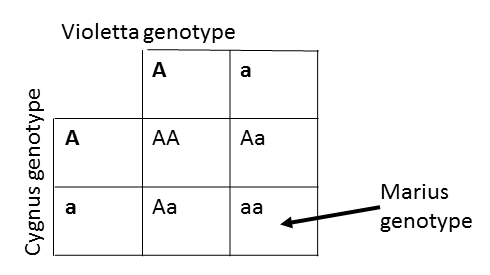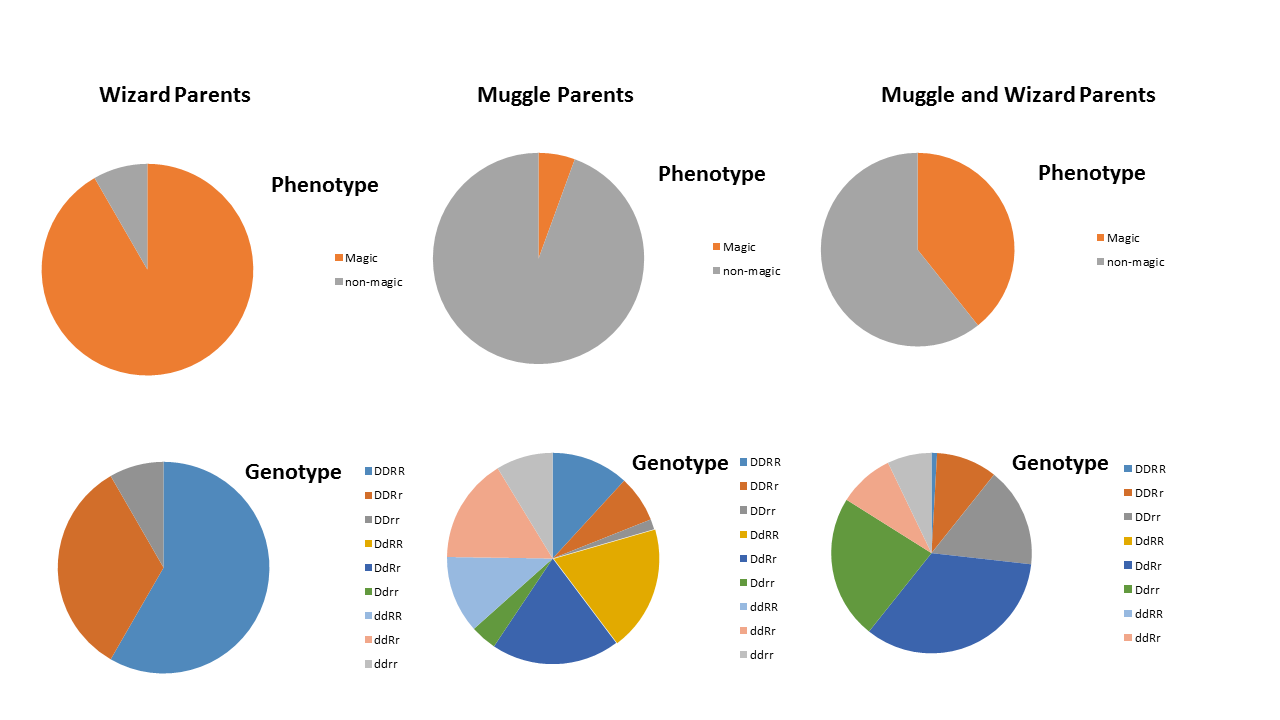A Wizarding Pedigree
by Hannah Weiss
Funnily enough, the question of genetics in the wizarding world started as an innocent conversation in an online forum. Of course, this was a discussion that all too quickly became a caps-locked debate about the intelligence of those involved, but the question itself was a good one. And one that stuck with me after I left. See, I grew up with Harry Potter--I’m only a year or so away from the Harry Potter generation (you know, the kids who were who were the same age as the golden trio in the first book), and a few years away from being the same age as the golden trio if the books had been happening in real time. I still hold to it that the only reason I didn’t get my Hogwarts letter, aside from being an american citizen, is that they were a little busy fighting a battle at the time I came of age. So I really grew up with Harry Potter. I also happened to grow up to be a biologist. All these things collided when I was re-reading Harry Potter--as one is wont to do--and realized that there are a lot of families in the books. Now, this may not come as a shock to you, as family is a somewhat important theme in the series, but for me this was almost a revelation. For many, a family is a group of people you somewhat tolerate at the holidays, but for me (and a lot of biologists), family history is genetic history. And if you have genetic history, you can work out the pattern of heredity for a given trait.
Probably.
Usually.
Definitely. Right? Yes! Constructing a model that explains the way that the genetics of wizarding works in the Harry Potter universe is at least a weekend project. But to do it, we’re going to have to revisit some dark memories because a lot of the tools and vocab that we need are from--what was for me anyway--Middle School Science. Yes, I know; Middle School was an awful time for all of us, but I will make this as painless as possible.
Ready? We only need two tools and a few words.
Tools:
Pedigree--These were those funky trees that your teacher drew on the board and tried to get you to make sense of, but they are way more powerful than just an excuse to draw in class. With these, we can visualize traits in a family.
Punnet Squares--These were kind of like those paper fortune tellers where you picked a color and then a number and found a possible fortune, except instead of colors and numbers, it’s one gene from each parent and the fortune is the the possible genes that the kids in a family could have and also the odds of those genes being passed on. So really...nothing like those paper fortune tellers, but really useful for seeing how likely sets of genes were
Words:
Genes--Those bits of DNA that you inherit that tell your body what to do; you inherit two copies of each gene, but only one from each parent
Alleles--Alternate copies of genes
Recessive--An allele that is only expressed if a person has two copies of it, usually represented by a lowercase letter
Dominant--An allele that is expressed if a person has at least one copy, usually represented by an uppercase letter
Genotype--The genes a person has; this is tracked in a punnett square
Phenotype--The way the genes are expressed or what you physically see, also called traits; this is tracked in a pedigree
OK, we’re back from Middle School. See, not too painful, I bet you even vaguely remembered some of those words. Probably at least one of them.
Now that we have our tools and vocab, we’re set and go back to our main question. Our idea. The reason that we had to return to Middle School in the first place: wizarding genetics. Can we find a model that fits the way that magic is inherited in the world of Harry Potter?
To do this, we’ll need to look at a family and see what we notice. Luckily enough, J.K. Rowling gave us the perfect case study in one of the books. We not only have an entire family tree for this family, but also can assume the phenotype of people who married in and those who were….aggressively pruned. That’s right, I’m talking about the Black Family. We have a tapestry¹ with all of their names on it and know that everyone marrying into the family had to be a magic user. We also have a few people who were burned off the tapestry, and while some of them were burned off for things like assisting Sirius Black or being Sirius Black, we do have one confirmed squib or non-magical person. This is incredibly important because it can help us rule in or out a variety of possibilities.
Looking at this pedigree we can see that most of the family shows this trait of magic use. Any geneticist or seventh grader worth their salt would look at this pedigree and say that it seems to match the pattern expected of a dominant trait. Of course, this conclusion would come from comparing the Black Family pedigree to the pedigrees of real genetic traits such as having freckles² --a trait that in our world is an example of a dominant human trait. A pedigree for the presence of freckles in a family might look like the one below.
In this pedigree you can see that if one parent has the trait then not only will most children show the trait, but so will most grandchildren. However, this pedigree also shows that if both parents do not have a trait then neither will their children.
If we look back at the Black Family pedigree then this really begins to look like a possible model for wizarding because if the parents are able to use magic then so are the majority of the children. Interestingly, if we assume that the trait is dominant, then we know that a squib will have two copies of the recessive allele. Essentially, we end up with this chart:
From our Punnett squares and also basic genetics we also know that for a squib to have two copies of a recessive allele then they would need to inherit one copy from each parent. In the example of the Black Family, Marius being a squib means that both Cygnus and Violetta had the genotype Aa.
But a genotype of “Aa” with magic use being represented by a dominant allele would still be able to use magic so we have a model with both parents being able to use magic but a chance that their child can not.
So, awesome, we’re good! We have a model that works. Clearly it’s a dominant gene, J.K. Rowling even said so, claiming on her website that magic is a “...dominant and resilient gene” ³.
So this is perfect, question answered!
Except, there’s a still a bit of text here so….it must not quite be perfect. And it’s not. If you look at this model really closely (or even just squint at it), it starts to fall apart. It’s recessive genes and muggle borns that cause the break down--you know, the same thing that had the ministry under Voldemort accusing muggle borns of stealing their magic. See, if the ability to use magic is a dominant gene, then non-magic users have to have two copies of recessive genes. This may not seem ground breaking but...well the punnett square would look like this:
None of the children can inherit a dominant gene and so none of them would be able to magic. So Muggle-borns like Hermione Granger are not possible using this simple model. And yes, there are other things that are possible like random mutations (although the number of muggle-born witches and wizards seems way too high for this) or epigenetics, but….I’m just not ready to open that can of worms.
So one gene is just not cutting it here, but what if we upped the number and looked at two genes? When we have two genes interacting, sometimes they can affect each other’s expression which is called epistasis. A good example of this is with albinism. It doesn’t matter what skin color you’ve inherited; if you have two copies of the recessive albinism gene then your phenotype is albino. So let’s imagine two genes inherited together, one with a dominant inheritance pattern and one with a recessive inheritance pattern. In order to be a magic user, one would need at least one copy of the dominant gene and two copies of the recessive gene. Our chart of phenotypes and genotypes would then end up looking like this:
If you are paying very close attention, you may have noticed that I added a new category for squibs, distinct from muggles and that’s because there is only one possible genotype combination that results in squibs--which is actually pretty cool because it may suggest that squibs are able to interact in the magical world in a way that most muggles can’t because of their genes, and not just as a result of being raised near that world.
Aside from that though, doing all of the possible crosses leaves you with this (where the pie graphs represent the genotype and phenotype probabilities of children born to wizard parents, muggle parents and a wizard and muggle parent):
This is, yes, a ton of information, but the important thing to take from it is that no matter the parental combination, you can get children who both can and can not use magic (the phenotype line)⁴.
This setup would completely explain muggles, squibs, muggle-borns, and the relative rarity of squibs. So great, we have a model that works, and even one that uses a dominant gene. Is this the only possible model? Absolutely not, but it is one possible model.
Of course, it did leave me wondering why non-magic users still existed in this world. Shouldn’t it be overwhelmingly beneficial to be able to wave a stick and have something happen?
Here’s where genetics gets really cool; we have this thing called heterozygote advantage. Basically, this is the idea that having mixed genes can be really advantageous, especially when it comes to diseases. Sickle cell anemia is a pretty classic example of this. It’s a recessive disorder, so one needs to inherit two copies of the allele to have sickle cell anemia, but if you only inherit one copy you can have what’s called sickle cell trait. And the sickle cell trait turns out to really help you survive bouts of malaria...which would let you pass on your genes...so that recessive gene might stick around even though having two copies is potentially disastrous.
Why am I bringing this up? Because there are wizarding only diseases, like dragon pox, that don’t seem to affect muggles or squibs. It may be that having one recessive copy of that dominant gene I suggested helps to survive these diseases. If that’s the case, then these alleles would stick around because our wizarding ancestors that had them would have been more likely to have kids. And really, at the end of the day that’s what genetics is all about; the alleles that move on and those that don’t.
References:
1: https://en.wikipedia.org/wiki/File:Black_family_tree.jpg
2:https://www.khanacademy.org/science/high-school-biology/hs-classical-genetics/hs-pedigrees /a/hs-pedigrees-review/e/hs-pedigreeshttps://www.khanacademy.org/science/high-school-biology/hs-classical-genetics/hs-pedigrees/e/hs-pedigrees
4: Punnett squares calculated with http://scienceprimer.com/punnett-square-calculator
ABOUT THE AUTHOR
Hannah Weiss is the Director of Education at the Science Museum of Western Virginia and has degrees in biology (with a math minor) and education. Unsuprisingly, Hannah is also a massive geek and has been involved in cosplay, writing fanfiction and thinking was too deeply about fandom since before she knew what those words meant.
Twitter: @Shoestring_Sci
Instagram: @shoestringscience









